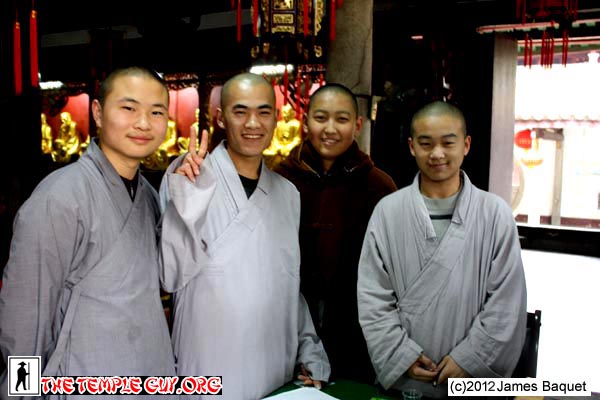(1) Many temples have a pair of guardians in the first hall, the "Mountain Gate." Most of those are the generals Heng and Ha, the first with a closed mouth, the second with an open one, representing Yin and Yang. At Kaiyuan Temple in Chaozhou, they both had closed mouths. Heng and Heng? All "yin," no "yang"?
It rained most of the night, so I dawdled getting out of my room until the heaviest part of the storm was past. I saw a lot of rain today, but was fortunate: I never had to open an umbrella.
(2) The Guest Office (Ke Tang) had this pretty little Guanyin-in-the-moon on their altar.
(3) The Main Hall has a temporary contraption in front of it; presumably, it's some way to fleece the suckers at New Years, but I haven't figured out how it works.
(4) Another (nicer) view of the Main Hall, with less of the "contraption" showing.
(5) Here it is, like a wedding cake with a groom and no bride.
(6) To either side of the first courtyard is a small courtyard and hall; that on the right is dedicated to Dizang, who vowed to save all beings from hell...
(7) ...hence, he's flanked by the Ten Judges of Hell (the five on the right are shown here).
(8) The courtyard on the other side is dedicated to Guanyin, the Bodhisattva of Compassion; here's the gateway to the courtyard. The configuration of these two (Guanyin on the left, Dizang on the right) is the same as if there were a drum and bell tower, which would house these two in the same relative positions.
(9) A major, pleasant surprise: on the right side of the complex, out near the street, is a courtyard with this Guanyin "Great Compassion" Hall and some really great statuary.
(10) In the front (street-side) gateway (which remains closed) is this fine one-piece Guanyin-with-attendants. Her face is unusually beautiful.
(11) Three sides of the hall's exterior are adorned with relief panels like this one. I'm dying to know the story they tell.
(12) The centerpiece of the hall's interior is back-to-back Thousand-Armed Guanyins.
(13) As you can see, the center statue is surrounded by smaller white ones in cases. In fact, there are 12 around this area, and a double-row totaling 72 more in a U-shape around that, constituting the 84 forms Guanyin can take (in one tradition).
(14) Here is just one of the 84; he looks like a shaman! I wish I had had time to shoot all of them, and the legends written beneath them.
(15) In a verge around the outside of the hall were 18 fine statues (maybe cast concrete?) of the 18 arhats, disciples of the Buddha. They mostly had the iconography I'm most familiar with (only 1 or 2 varied) so I can use them for teaching; the ones I see inside halls are too hard to shoot! This one is the "dragon-taming arhat."
(16) This one is seated in meditation; I love the way he was placed in front of a sort of bonsai tree; I would love to build a garden like this! (I did shoot all 18 of these guys.)
(17) On the opposite side of the temple, balancing the Guanyin courtyard, is a Buddhist college. One of the buildings is this hall with eight reliefs on the front showing the life of a modern monk (I think).
(18) Here's one panel from that building.
(19) In the back left corner of the complex's public area was this unusual hall dedicated to the "24 Zhutian" (诸天) which just means something like "various gods," a collection of kings and generals, most of whom originated in India. At the center is Bodhidharma, the first patriarch of Chan (Zen), a kind of strange placement for him. I was so impressed, I did my devotions in this very quiet room.
(20) Three of the 24 Zhutian.
(21) Finally, I had some fun with these young monks, trying to get the names of some of the figures I had seen in the halls, but couldn't identify. Their English was absolutely nil; I trotted out my minimal Chinese, and we wrote, mimed, and pointed a lot (as usual). Their goodwill was evident, and I'm grateful for that.
--------
I walked out to a bus stop on a busy street and waited an hour; not even a city bus went by! It was the afternoon of New Years Day and lots of things were shut down--apparently including Chaozhou's public transit system!
I then walked 15 minutes and entered an open bus station; when I said "Shantou" the girl told me there were no buses. Not believing her, I walked on and--my good karma, I guess--a Shantou bus passed. I flagged it and got on and--believe it or not--he pulled into the very station where the girl had told me minutes before that there were no buses to Shantou!
I wanted to get out and give her a "neener-neener-NEEENer" but figured I'd best play it cool. Less than an hour later I was back in Shantou. And that's quite nearly the end of the trip.
| ← Previous Site | Back to Trip 14 Introduction | Next Trip → |
Last Updated August 11, 2019






















No comments:
Post a Comment